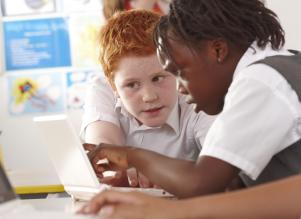2/5/2017
How to Motivate Students Using Competitive and Collaborative Activities
Don't have time to read? |
Staying motivated to read can be a challenge for many students, especially those who are reading below grade level. Some students are motivated to keep working for external, competitive reasons—they want to earn a good grade, win a contest, etc.
On the other hand, collaborative activities encourage students to learn from each other with less pressure to perform, which is a more appealing option for other students. So, which motivational strategy should educators use: competition or collaboration?
A 2013 article from Concordia University says that competitive and collaborative strategies both have pros and cons. Rather than choosing a purely collaborative classroom or an entirely competitive learning environment, the article suggests a middle ground: “Given that competitive and cooperative teaching strategies each have their advantages, both could be incorporated into a classroom—provided teachers remain on guard against the pitfalls of each strategy.”
It goes without saying that students who struggle with reading need to stay motivated in order to practice their skills and learn new strategies. Below, we’ve reviewed the benefits of both competitive and cooperative strategies for students who are struggling with reading.
Competition
Although education is far more important than either “winning” or “losing,” Dr. Sylvia Rimm, director of the Family Achievement Clinic in Cleveland, Ohio, suggests competition can be a great motivator for students in certain circumstances. Dr. Rimm notes several benefits of teaching healthy competition, and while she acknowledges the motivation of winning and being the “best” in a competition, she also explains how the experience of losing is important for students. “When failure occurs, they can identify the problems, remedy the deficiencies, reset their goals, and grow from their experiences,” says Dr. Rimm. This is an important talking point for educators because even though the main focus is on helping students feel successful, it’s also necessary for students to feel—and learn from—loss.
While competition can be beneficial, it also has pitfalls. External motivating factors may motivate certain students to study more or complete homework, but they are not effective in the long term. For example, while a contest for homework completion may motivate a student for a few weeks, that same student may stop completing homework once the external motivation of a contest is removed. For a student struggling in a particular subject area, the idea of a competition may seem too daunting and intimidating, resulting in the student not trying at all. It is important to understand that certain motivational techniques can produce different results depending on how they are used, as well as the individual student.
Collaboration
If Dr. Rimm advocates for healthy competition to motivate students, Dr. Spencer Kagan advocates for the benefits of a collaborative classroom. Dr. Kagan is the author of the book Cooperative Learning, and readily admits that he favors collaboration over competition. One of the benefits Dr. Kagan notes in an article on cooperative learning is that students have more opportunities for self-knowledge and self-realization when they work in groups. “Students in interaction with others learn about themselves,” Dr. Kagan says. A student working alone or in competition with others may not realize that he or she is studying differently from the other students or that he or she does not read as often or as well. Students who are reading behind their classmates can benefit from collaborative learning by finding both models and motivators in their peers. Here are a few strategies for using cooperative learning to motivate students, especially those who are struggling with reading:
-
Group reading discussions
After reading a short story, ask students to discuss their thoughts on the text’s meaning, significance, and appeal. Ask students to share experiences from their own lives that are similar or different from the story. Sharing their ideas will help students express themselves, relate to each other, and learn new perspectives, too.
-
Partner reading
Paired or partner reading allows students to take turns reading aloud and listening to their classmates read. This gives students who are struggling with reading a chance to learn from a peer model while also receiving encouragement in a one-on-one setting. Reading with one student may also be much less intimidating than reading in front of the whole class.
-
Performing plays, skits, and dramatic readings
If students are reluctant to read aloud in front of the class, participating in a dramatic read-aloud can help ease the pressure. When all students are reading aloud from a script, students can focus on how they are contributing to a whole class experience rather than their individual performance.
-
Compiling a group anthology
Encourage students to contribute one of their favorite poems, plays, or short stories to a class anthology. Reading a collection of favorite works will expose students to new reading material recommended by their peers!
Sometimes, a short-term, fun competition may be exactly what a class needs to break the daily monotony. For a more long-term approach to motivation, collaborative and cooperative activities offer students a chance to learn more about themselves and how they can grow through working with their peers. Both competitive and collaborative techniques can help students with motivation, but only when properly understood and implemented.


